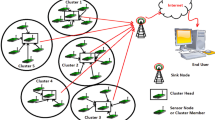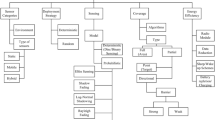Abstract
Wireless sensor networks generally have unique lifetime necessities. In any case, the density of the sensors may not be sufficiently substantial to fulfil the coverage requirement while meeting the lifetime constraint in the mean time. Once in a while coverage has to be traded for network lifetime. The proposed efficient pipeline based spatial temporal optimization scheduling for coverage optimization satisfies the coverage problem while meeting the lifetime constraint at the same time. In the proposed optimal scheduling, initially number of nodes in the network is clustered by using energy based one hop clustering algorithm. After the formation of clusters pipeline based spatial temporal optimization algorithm is used for the optimal scheduling. Here the optimization is improved by using trust of each sensor nodes and the area of clusters. Finally, data is aggregated through the optimally scheduled cluster nodes. The experimental results show that our proposed optimization scheduling substantially outperforms other schemes in terms of network lifetime, coverage redundancy and convergence time.
Access this article
We’re sorry, something doesn't seem to be working properly.
Please try refreshing the page. If that doesn't work, please contact support so we can address the problem.






Similar content being viewed by others
References
Patel, M., & Wang, J. (2010). Applications, challenges, and prospective in emerging body area networking technologies. IEEE Wireless Communications, 17(1), 80–88.
Sobeih, A., Hou, J. C., Kung, L.-C., Li, N., Zhang, H., Chen, W.-P., et al. (2006). J-Sim: A simulation and emulation environment for wireless sensor networks. IEEE Wireless Communications, 13(4), 104–119.
Pedraza, J. M. (2017). Advanced nuclear technologies and its future possibilities. In Small modular reactors for electricity generation (pp. 35–122). Springer International Publishing.
Akkaya, K., & Younis, M. (2005). A survey on routing protocols for wireless sensor networks. Ad Hoc Networks, 3(3), 325–349.
Patwari, N., Ash, J. N., Kyperountas, S., Hero, A. O., Moses, R. L., & Correal, N. S. (2005). Locating the nodes: cooperative localization in wireless sensor networks. IEEE Signal Processing Magazine, 22(4), 54–69.
Howard, A., Matarić, M. J., & Sukhatme, G. S. (2002). Mobile sensor network deployment using potential fields: A distributed, scalable solution to the area coverage problem. In Distributed autonomous robotic systems (vol. 5, pp. 299–308). Springer, Japan.
Soro, S., & Heinzelman, W. B. (2009). Cluster head election techniques for coverage preservation in wireless sensor networks. Ad Hoc Networks, 7(5), 955–972.
Younis, O., Krunz, M., & Ramasubramanian, S. (2006). Node clustering in wireless sensor networks: Recent developments and deployment challenges. IEEE Network, 20(3), 20–25.
Cardei, M., & Jie, W. (2006). Energy-efficient coverage problems in wireless ad-hoc sensor networks. Computer Communications, 29(4), 413–420.
Romer, K., & Mattern, F. (2004). The design space of wireless sensor networks. IEEE Wireless Communications, 11(6), 54–61.
Moreira, A., Krieger, G., Hajnsek, I., Papathanassiou, K., Younis, M., Lopez-Dekker, P., et al. (2015). Tandem-L: A highly innovative bistatic SAR mission for global observation of dynamic processes on the Earth’s surface. IEEE Geoscience and Remote Sensing Magazine, 3(2), 8–23.
Yang, Q., He, S., Li, J., Chen, J., & Sun, Y. (2015). Energy-efficient probabilistic area coverage in wireless sensor networks. IEEE Transactions on Vehicular Technology, 64(1), 367–377.
Petrioli, C., Nati, M., Casari, P., Zorzi, M., & Basagni, S. (2014). ALBA-R: Load-balancing geographic routing around connectivity holes in wireless sensor networks. IEEE Transactions on Parallel and Distributed Systems, 25(3), 529–539.
Golrezaei, N., Mansourifard, P., Molisch, A. F., & Dimakis, A. G. (2014). Base-station assisted device-to-device communications for high-throughput wireless video networks. IEEE Transactions on Wireless Communications, 13(7), 3665–3676.
Erol-Kantarci, M., & Mouftah, H. T. (2015). Energy-efficient information and communication infrastructures in the smart grid: A survey on interactions and open issues. IEEE Communications Surveys & Tutorials, 17(1), 179–197.
Sharma, K. P., & Sharma, T. P. (2016). ZBFR: Zone based failure recovery in WSNs by utilizing mobility and coverage overlapping. Wireless Networks, 23(7), 2263–2280.
Younis, M., Senturk, I. F., Akkaya, K., Lee, S., & Senel, F. (2014). Topology management techniques for tolerating node failures in wireless sensor networks: A survey. Computer Networks, 58, 254–283.
Tang, M., Yan, F., Deng, S., Shen, L., Kuang, S., & Xing, S. (2016). Coverage optimization algorithms based on voronoi diagram in software-defined sensor networks. In 2016 8th international conference on wireless communications & signal processing (WCSP) (pp. 1–5). IEEE.
Govindan, R., Korre, A., Durucan, S., & Imrie, C. E. (2011). A geostatistical and probabilistic spectral image processing methodology for monitoring potential CO2 leakages on the surface. International Journal of Greenhouse Gas Control, 5(3), 589–597.
Leipold, F., Tassetto, D., & Bovelli, S. (2013). Wireless in-cabin communication for aircraft infrastructure. Telecommunication Systems, 52(2), 1211–1232.
Mini, S., Udgata, S. K., & Sabat, S. L. (2014). Sensor deployment and scheduling for target coverage problem in wireless sensor networks. IEEE Sensors Journal, 14(3), 636–644.
More, A., & Raisinghani, V. (2014). Random backoff sleep protocol for energy efficient coverage in wireless sensor networks. Advanced Computing, Networking and Informatics, 2, 123–131.
Han, G., Liu, L., Jiang, J., Shu, L., & Hancke, G. (2017). Analysis of energy-efficient connected target coverage algorithms for industrial wireless sensor networks. IEEE Transactions on Industrial Informatics, 13(1), 135–143.
Jameii, S. M., Faez, K., & Dehghan, M. (2015). AMOF: Adaptive multi-objective optimization framework for coverage and topology control in heterogeneous wireless sensor networks. Telecommunication Systems, 61(3), 515–530.
Author information
Authors and Affiliations
Corresponding author
Additional information
Publisher's Note
Springer Nature remains neutral with regard to jurisdictional claims in published maps and institutional affiliations.
Rights and permissions
About this article
Cite this article
Choudhuri, R., Das, R.K. Efficient Area Coverage in Wireless Sensor Networks Using Optimal Scheduling. Wireless Pers Commun 107, 1187–1198 (2019). https://doi.org/10.1007/s11277-019-06331-z
Published:
Issue Date:
DOI: https://doi.org/10.1007/s11277-019-06331-z




